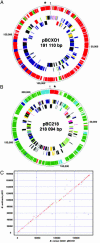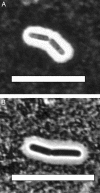Identification of anthrax toxin genes in a Bacillus cereus associated with an illness resembling inhalation anthrax
- PMID: 15155910
- PMCID: PMC420414
- DOI: 10.1073/pnas.0402414101
Identification of anthrax toxin genes in a Bacillus cereus associated with an illness resembling inhalation anthrax
Abstract
Bacillus anthracis is the etiologic agent of anthrax, an acute fatal disease among mammals. It was thought to differ from Bacillus cereus, an opportunistic pathogen and cause of food poisoning, by the presence of plasmids pXO1 and pXO2, which encode the lethal toxin complex and the poly-gamma-d-glutamic acid capsule, respectively. This work describes a non-B. anthracis isolate that possesses the anthrax toxin genes and is capable of causing a severe inhalation anthrax-like illness. Although initial phenotypic and 16S rRNA analysis identified this isolate as B. cereus, the rapid generation and analysis of a high-coverage draft genome sequence revealed the presence of a circular plasmid, named pBCXO1, with 99.6% similarity with the B. anthracis toxin-encoding plasmid, pXO1. Although homologues of the pXO2 encoded capsule genes were not found, a polysaccharide capsule cluster is encoded on a second, previously unidentified plasmid, pBC218. A/J mice challenged with B. cereus G9241 confirmed the virulence of this strain. These findings represent an example of how genomics could rapidly assist public health experts responding not only to clearly identified select agents but also to novel agents with similar pathogenic potentials. In this study, we combined a public health approach with genome analysis to provide insight into the correlation of phenotypic characteristics and their genetic basis.
Figures




References
-
- Cherif, A., Brusetti, L., Borin, S., Rizzi, A., Boudabous, A., Khyami-Horani, H. & Daffonchio, D. (2003) J. Appl. Microbiol. 94, 1108-1119. - PubMed
-
- Logan, N. A. & Turnbull, P. C. (1999) in Manual of Clinical Microbiology, ed. Murray, P. R. (Am. Soc. Microbiol., Washington, DC), pp. 357-369.
Publication types
MeSH terms
Substances
Grants and funding
LinkOut - more resources
Full Text Sources
Other Literature Sources
Medical
Molecular Biology Databases

